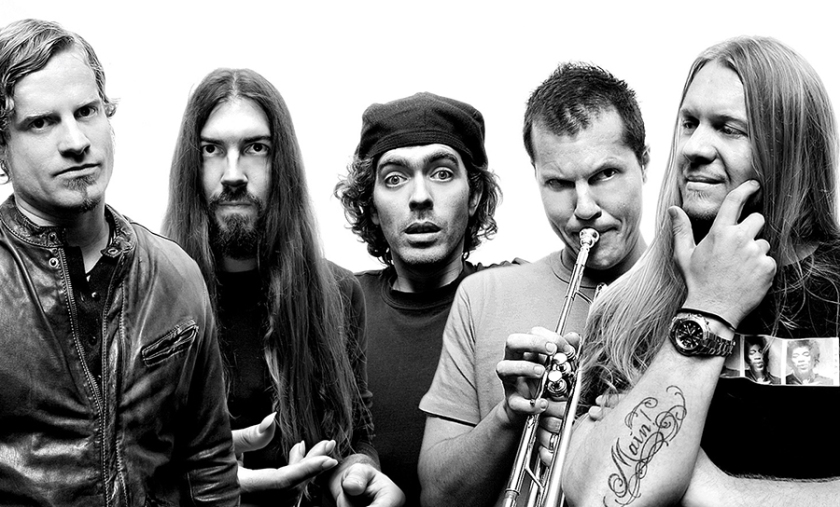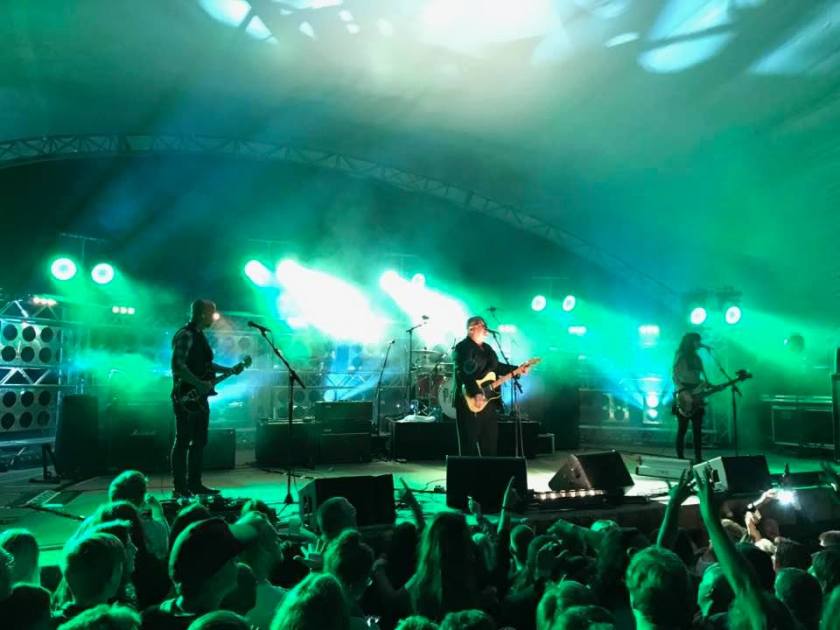
Young people, here’s a sad truth: that tribe you inhabit that seems to own the streets and the night-spots, that defines what’s hip and what the issues are? They’ll one day retreat into cars and offices, homes and restaurants, and they’ll mysteriously disappear from view and be replaced by another tribe that despises all yours stood for. But just occasionally they may re-emerge, blinking in the light.
The crowd for The Pixies at Kirstenbosch constituted an informal reunion of Cape Town’s Generation X. We had the experience, all but forgotten, of recognising many faces (usually a little greyer and a little stouter) in the crowd without necessarily knowing names or even where we’d seen each other before.
And there on a wide stage were the alleged best bands of our generation. In the local case, The Springbok Nude Girls, opening for the internationally beloved Pixies. Named for the cover girls on a series of compilation records put out by Springbok Radio in the ’70s, and ’80s, Stellenbosch’s Nude Girls seemed improbably original with machine gun vocals, a trumpet that danced over the grunge guitar chords, and the echoing whoops that made square-jawed frontman Arno Carstens into an almost credible South African equivalent of a celebrity.

This time Carstens looked in his skinny jeans like a rugby player shyly enjoying his first adult ballet class. His total contempt for his audience had gone and with it much of his fuck-the-rules power. While guitar player, Theo Crous, laid into his Telecaster with every ounce of his ’90s vim, and the new (I presume) drummer was giving it hell, Carstens and bass player, Arno Blumer, seemed to be phoning it in. He could no longer reach those iconic whoops, which had to be filled in by Adriaan Brandt on the trumpet.
That’s not to say that the audience wasn’t loving it, which may tell you that I may not have been in entirely the right headspace. They roared along with the well-loved tunes and called out for more. I was dead centre, about three metres from the stage, and was probably getting most of my sound from the stage amps and monitor speakers. I’m pretty sure the sound was a lot better a few metres back catching the convergence of the main speaker towers. But I couldn’t help thinking, unfairly or not, that this being the greatest South African band of the ’90s says more about the ’90s than about them.
South Africans are so starved of international musicians that women behind us were yelling at The Pixies’ guitar tech* to take his pants off. Jason was naturally quick to join them. The band came on in darkness and opened without a word in a blaze of light and much improved sound. If I was still only getting stage sound, it was a lot louder and a lot clearer.

The wordless opening was no mere device. As the band went through a careful mix of well-worn classics and songs from their recent record, Head Carrier, with hardly a pause between any of them, the Alfred Hitchcockesque figure of Frank Black (who still goes by his given Charles Thompson in private) said not a word to the audience. Neither did slender, well-preserved guitar player Joe Santiago. In fact, neither of these two remaining primary icons of The Pixies seemed to even look at, or take in the audience at all. It was new bass-player, Paz Lenchantin, and drummer, David Lovering, who gave signs of being present in Cape Town.
Their performance though, was faultless. They hit all of their best loved numbers (besides former bass-player, Kim Deal’s, signature piece, Gigantic) with energy and conviction. Black never shied away from the screaming choruses that electrified us in the band’s glory days of the late ’80s and early ’90s and, despite not being a technical guitar player, Joe Santiago nailed every fiercely original part he ever wrote.
The crowd surged ecstatically for their biggest numbers, with the youngsters hopping onto the stage and being hurled off again by stagehands like kittens. I loved hearing numbers like This Monkey’s Going to Heaven, and Debaser. But some of their biggest numbers I’ve so over-played that they left me a bit cold. I actually found myself bored by their best-known tune, Where Is My Mind–waiting for it to end.
Where I lost myself completely was in the new numbers like Tenement Song and especially Magdalena–songs which prove that Black’s song-writing has only matured and refined over 30 years–the dreamy Bossanova numbers, Velouria and Havalina, and their cover of The Jesus and Mary Chain’s Head On.
After they’d blasted through about twenty five tunes, they acknowledged the audience for the first time, still wordlessly, took some bows, did a single encore, and then it was done. I don’t wish to suggest that my experience was universal, but I found the professional but impersonal style of Black and Santiago a barrier to immersing myself fully in experiencing the performance of a band I’ve adored for two and a half decades. They gave no indication that they had any investment in playing to this audience in this city, and I think many of us want that illusion from our artistic heroes. They literally did not speak a single word to the crowd. Lovering though, who never flagged in what must have been a truly gruelling performance, was beaming during the bows, which counted for something.
I’ll avoid saying too much about the behaviour of my generation. I shouted at one old fool who was trying to relive his youth at the expense of everyone around him. “Moshing,” was one of the shittiest, whitest, notions of the ’90s. It’s even worse if it’s not kept to the front of the stage where participation can be considered consensual.
*Guitar nerd note: I love a band with great taste in guitars, and The Pixies have that. Even a non guitar nerd friend was impressed by Joey Santiago’s black and gold, Bigsby’d Les Paul Custom (you see guitar folks? People do notice). A cherry ’60s Bigsby’d ES345 and a pick-guardless dark-back ’57 reissue goldtop rounded out his choices. Black played a well-worn blonde Telecaster. Bass player, Paz Lenchantin, used a covetable, well-worn, off-white Precision, with a red/tortoiseshell guard (with a scarlet flower attached to the headstock), that may have been an original or some kind of distressed reissue. Joey played through a master volume JCM800 and a Fender Princeton or Deluxe Reverb. Black played through a small pile of AC30s. It’s a good example of how to get tonal separation between two guitars.

I was going to write this, but now I don’t have to, thank you. Mirrors my experience almost entirely, except for the part where you cared about the Pixies’ lack of audience acknowledgement/rapport. I was standing about 50m back so it didn’t feel as blank, perhaps. Also, I think I was just so stunned at how blisteringly tight the codgers still are that I was buzzing hard off confounded expectations.
Thanks! Yeah. I tried to make it clear that not everyone would have shared my experience and feelings which you’ve picked up. I feel like they should have a small set of speakers for those right at the front of the house.